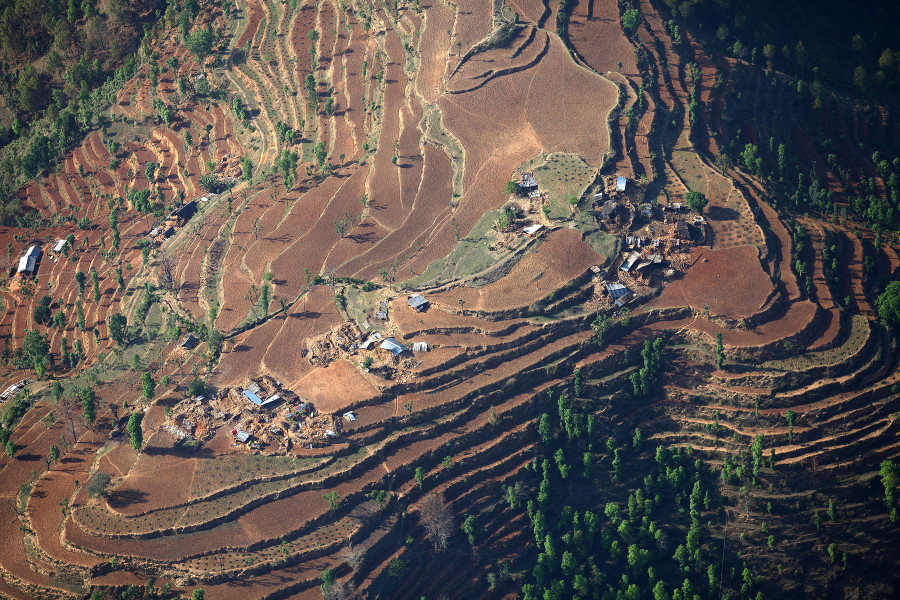Columns
Challenges to food production
We will need more than just enhanced seeds and mechanisation to sustain agriculture.
Madhukar Upadhya
The government’s programme and budget for the 2022-23 fiscal year aim to reduce food imports by increasing the production of rice, maize, vegetables and fruits by about 30 percent. The programme also emphasises improving the state of agriculture through mechanisation and promoting a climate-adapted agriculture system. Janardan Sharma, the current finance minister, asked agricultural authorities to prepare a plan to provide improved seeds to farmers this year which would help increase paddy production threefold. These are sound ideas since the goal of the agriculture programme must be to improve food production and reduce its import, but will our ground reality allow these ambitious plans to materialise?
A significant challenge we face is the shortage of fertiliser. While Nepal requires about 1.2 million tonnes of fertiliser annually, the government hasn’t been able to import even half of that. The fertiliser shortage has been a persistent problem, and probably the most politicised subject within the agriculture administration. What’s worse is this problem doesn’t appear to be going away soon. When fertiliser does become available, it’s usually late. Agriculture science clearly states that for all crops, there are specific fertiliser usage windows for optimal results. Under the given circumstances, farmers are barely able to use these windows. Food production cannot flourish without adequate, timely fertiliser application.
Labour shortage
Labour is another challenge. Managing labour is a difficult task for farmer households, which has discouraged many from continuing farming since hiring labour is expensive; understandably, farmers opt out of agriculture to pursue other work, making it easy for them to buy food from the import-based market rather than produce their own. Therefore, the belief that "two-thirds of the population is engaged in farming" needs revision to establish the actual number of full-time farmers. While the mechanisation of agriculture can help solve this problem to an extent, it’ll take several years for that to take effect.
Even if we manage the fertiliser and labour issues, agriculture is faced with another burgeoning problem: the climate crisis. It’s already begun to impact agriculture in several ways—from increased droughts and frequent floods to insect/pests and diseases. These impacts are growing in number, and they’re beginning to snowball with devastating effects on food production. Without addressing them, achieving sustained higher food production is unthinkable.
While our domestic data may be limited, emerging global and regional events give us ground data to speculate on the nature of possible, imminent scenarios at home. Globally, drought frequency and duration have increased by 29 percent since 2000. Heat waves across the world have already reached alarming levels. The recent heat waves across South Asia are merely a prelude to what’s in store for us in the coming years. April 2022 was the hottest month for India in 122 years and for Pakistan in 61 years. On May 14, Jacobabad in Pakistan recorded temperatures up to 51 degrees Celsius. The heat wave resulted in an almost 50 percent reduction in wheat crop yield in the worst-hit areas. Interestingly, almost simultaneously, floods devastated villages in Bangladesh even before the monsoon.
These erratic weather patterns are the outcome of warming seas and the atmosphere. Global temperatures have increased by 1.2 degrees Celsius above pre-industrial levels due to runaway carbon emissions in the last 200 years. Temperatures continue to rise. If left unchecked, temperatures could easily reach 1.5 degrees Celsius above those pre-industrial levels within the next five years, as predicted by scientists—a direct result of the failure of global communities to reduce emissions as promised at several climate summits since the Paris Agreement in 2015.
The fossil fuel industry remains hell-bent on prioritising its profit margins, sending the concentration of greenhouse gases in the atmosphere soaring with no real fear of consequences. To highlight how governments have neglected the emission cut targets, the UN Secretary-General, Antonio Guterres, said that our addiction to fossil fuel is killing us.
What’s vital for us to realise is that climate impacts caused by rising temperatures affect us more than most vulnerable countries. The richness of Nepal’s biodiversity, our natural crowning jewel, also means diverse and complex climatic conditions, creating varied climate impacts of different scales. For the last few decades, we’ve noticed changes like rainfall: recurring hailstorms, the timing and frequency of floods, reduced cold months, and their overall impacts on food production. Groundwater is rapidly declining. All of this is happening concurrently, and we have no clue how to begin addressing them.
A recent study in India showed that several districts in Punjab, a major food-producing state, only have 17 years before the groundwater dries out completely. This development should be ringing alarm bells among our policymakers; we’re located at the head watershed area of the adjacent basin, and, thus, Punjab’s depleting groundwater concerns us too.
Addressing the problem
Though the new policy has especially emphasised becoming carbon neutral to address climate change, it won’t be effective enough to reduce rising temperatures. In contrast, the impacts will affect us more and more. The knowledge regarding climate impacts generated within the country so far has been broad and operational, aimed to raise awareness about the issue; however, it remains pretty inadequate to pinpoint any improvements needed at the local level, which is as diverse as our landscape.
In such a situation, how can farmers adapt to evolving impacts?
The recently conducted local elections presented an opportunity to reflect on how candidates viewed the climate impacts affecting their constituencies. Their manifestos focused chiefly on traditional sectors such as health, water supply, sewage management, education and infrastructure. Climate impacts were noticeably absent from their campaign pledges. The candidates knew that our food travels hundreds of kilometres before reaching us. Imported foods have penetrated even rural areas, yet only a few candidates considered domestic food production an issue.
Sadly, most opinion-makers have gravely misunderstood the climate crisis as the next stage of environmental problems, which it is not. They are distinct. Environment issues are always local and can be managed relatively quickly. However, climate impacts are primarily regional and often encompassing. A deeper understanding and greater, sustained efforts are required to address them.
We cannot afford to import expensive food forever. But we will have no choice if we persistently fail to recognise agriculture’s climate crisis. The ongoing situation will significantly alter the ecosystems we’re familiar with for good. Therefore, the challenges in sustaining, let alone improving, agriculture requires more than just enhanced seeds and mechanisation.




 13.12°C Kathmandu
13.12°C Kathmandu















